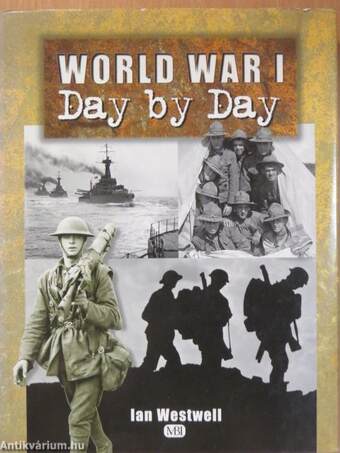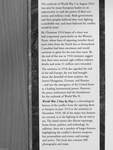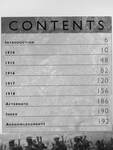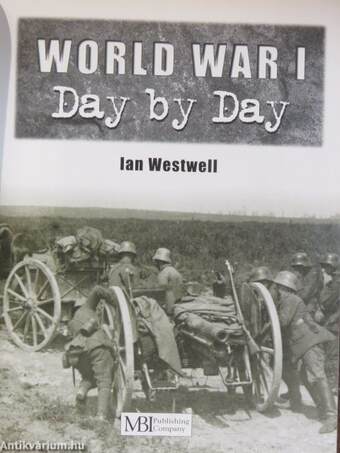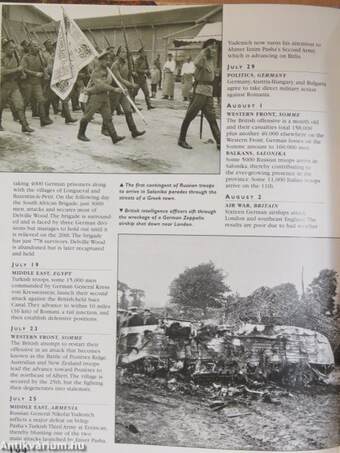1.066.456
kiadvánnyal nyújtjuk Magyarország legnagyobb antikvár könyv-kínálatát

VISSZA
A TETEJÉRE
JAVASLATOKÉszre-
vételek
World War I Day by Day
| Kiadó: | MBI Publishing Company |
|---|---|
| Kiadás helye: | Osceola |
| Kiadás éve: | |
| Kötés típusa: | Fűzött kemény papírkötés |
| Oldalszám: | 191 oldal |
| Sorozatcím: | |
| Kötetszám: | |
| Nyelv: | Angol |
| Méret: | 29 cm x 22 cm |
| ISBN: | 0-7603-0938-8 |
| Megjegyzés: | Fekete-fehér fotókkal, térképekkel. |
naponta értesítjük a beérkező friss
kiadványokról
naponta értesítjük a beérkező friss
kiadványokról
Fülszöveg
The outbreak of World War I in August 1914
was seen by many European leaders as an
opportunity to curb the power of their eco-
nomic and military rivals. Both governments
and their peoples believed they were fighting
a justifiable war, and most believed the conflict
would be brief.
By Christmas 1914 hopes of a short war
had evaporated, particularly on the Western
Front, where lines of opposing trenches faced
each other from the North Sea to Switzerland.
Casualties had been enormous and would
continue to grow for the next four years. By
the end of the war in 1918 estimates suggest
that there were around eight million military
deaths and some 21 million men wounded.
The armistice in 1918 also signaled the end
of the old Europe; the war had brought
about the downfall of three empires: the
Austro-Hungarian, German, and Russian
- and saw the emergence of the United States
as a leading international power. However,
the peace settlements laid the foundations
for... Tovább
Fülszöveg
The outbreak of World War I in August 1914
was seen by many European leaders as an
opportunity to curb the power of their eco-
nomic and military rivals. Both governments
and their peoples believed they were fighting
a justifiable war, and most believed the conflict
would be brief.
By Christmas 1914 hopes of a short war
had evaporated, particularly on the Western
Front, where lines of opposing trenches faced
each other from the North Sea to Switzerland.
Casualties had been enormous and would
continue to grow for the next four years. By
the end of the war in 1918 estimates suggest
that there were around eight million military
deaths and some 21 million men wounded.
The armistice in 1918 also signaled the end
of the old Europe; the war had brought
about the downfall of three empires: the
Austro-Hungarian, German, and Russian
- and saw the emergence of the United States
as a leading international power. However,
the peace settlements laid the foundations
for the outbreak of World War II.
World War I Day by Day is a chronological
history of the conflict from the opening shots
at Sarajevo in June 1914 to the armistice in
November 1918. All of the major war theaters
are covered, as is the fighting in the air and at
sea. The dated entries also discuss espionage,
home fronts, politics, and technology. In
addition, there are a number of longer features
highlighting the conflict's decisive weapons,
key personalities and events, and strategy
and tactics. The book also contains 400
photographs and maps. Vissza
Témakörök
- Idegennyelv > Idegennyelvű könyvek > Angol > Műszaki
- Idegennyelv > Idegennyelvű könyvek > Angol > Történelem > Egyéb
- Történelem > Kézikönyvek > Kronológiák
- Történelem > Idegennyelvű > Angol
- Történelem > Legújabb kor > I. világháború
- Történelem > Hadtörténet > Háborúk, csaták
- Műszaki > Idegennyelv > Angol
- Műszaki > Hadászat, hadtörténet
Ian Westwell
Ian Westwell műveinek az Antikvarium.hu-n kapható vagy előjegyezhető listáját itt tekintheti meg: Ian Westwell könyvek, művekMegvásárolható példányok
Nincs megvásárolható példány
A könyv összes megrendelhető példánya elfogyott. Ha kívánja, előjegyezheti a könyvet, és amint a könyv egy újabb példánya elérhető lesz, értesítjük.



